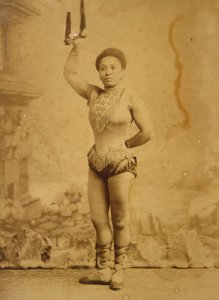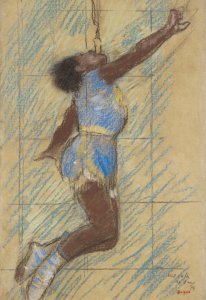Until 1st September 2024, the National Gallery is hosting a free exhibition called Discover Degas & Miss La La, focusing on Edgar Degas‘ (1834-1917) painting, Miss La La at the Cirque Fernando. Painted in 1879, it is Degas’ only circus painting and features a mixed-race acrobat known as la femme canon. Miss La La, or Anna Albertine Olga Brown (1858-1945), had a reputation for hanging upside down from a trapeze with a cannon suspended on chains held in her teeth. Featuring previously unseen sketches by Degas and unpublished photographs, the National Gallery exhibition turns the spotlight on the remarkable Miss La La.
Born in former German/Prussian territory, Szczecin, to a black father and white mother, Anna Olga Albertine Brown began touring with the circus at nine or ten. Whilst she went under many names, including Venus of the Tropics and African Princess, she became predominantly known as Miss La La by her 20s after joining the La La Kaira troupe.
In 1878, Miss La La debuted in Paris with the Kaira Troupe at the Cirque Fernando, performing to thousands of spectators, including Edgar Degas. She performed a flying trapeze and human cannonball act, but her signature acts involved using her teeth. By biting down on a rope or trapeze, Miss La La dangled at 200 feet. She also hoisted other people by a rope or held a 200-pound cannon from a leather strap in her mouth. The highlight of the performance involved lighting and firing the cannon without losing her grip.
In 1882, Miss La La partnered with Theophilia Szterker, who used the stage name Kaira. Crowds of admirers gave them the moniker “the Black and White Butterflies”, emphasising their different races and delicate movements. Together, they performed in various circuses, theatres and music halls, particularly in Madrid. They demonstrated the “silver plated machine”, consisting of revolving trapezes, from which they flitted back and forth. The pair continued to perform together until Kaira fell to her death in 1888. For some time, Miss La La continued the act alone with the stage name “African Butterfly”.
Miss La La did not let her skin colour or gender hinder her career. She took charge of her acts, often choreographing her aerial performances, although occasionally employed an agent. In 1888, she married Manuel Woodson, an African American contortionist, who did not prevent Miss La La from continuing her professional life. After a decade, the couple eventually settled down to start a family. They bought a home in Brussels where Miss La La, now known as Olga, ran a cafe and an inn for stage artists. She also managed her daughter and niece’s acting careers until she died in 1945.
Degas watched Miss La La several times at the Cirque Fernando in 1878 and 1879, often with a sketchbook. Sitting as high up as he could, Degas made cursory sketches of Miss La La performing her rope-and-pulley act. Eventually, Degas invited her to his studio, where she recreated her pose for Degas’ preparatory sketches and pastel drawings. Although he drew Miss La La many times, Miss La La at the Cirque Fernando was Degas’ only oil painting.
Although Degas was an impressionist artist, going against traditional painting styles, he continued to follow the academic method of progression. He began with sketches on location before moving to studio studies. Next, Degas started tackling composition and mocking up draft versions in pastels. As seen in some of Degas’ studies, he used a grid system to help transfer the design onto canvas.
Painting a named black woman was unusual in Degas’ time. The majority of black figures remained anonymous, although recent research has attempted to name many of these people. Degas perhaps identified with his mixed-heritage sitter, because he too came from a mixed-heritage family. Degas’ mother, whilst white, came from a Creole background. Historians suggest Miss La La may have reminded Degas of some of his maternal relatives.
Before painting Miss La La at the Cirque Fernando, Degas spent time with his family in New Orleans. Many relatives worked as white cotton merchants, which heavily involved the slave economy. Degas had never seen so many Black people before and was impressed with the “Black World”. He found these people fascinating and beautiful, and they became part of several paintings Degas produced at the time.
Miss La La at the Cirque Fernando initially attracted little attention and did not sell. Degas kept the painting in his studio for 25 years before trying his luck outside France. Eventually, a Canadian billionaire bought the artwork, and it remained in Toronto until 1925 when the National Gallery purchased it with the Courtauld Fund.
As proved by today’s exhibition, Degas’ painting of Miss La La was a success, albeit not in Degas’ lifetime. Several artists have taken inspiration from the artwork, for instance, Laura Knight (1877-1970), Thérèse Lessore (1884-1945) and her husband, Walter Sickert (1860-1942), and Duncan Grant (1885-1978).
Discover Degas & Miss La La is part of the National Gallery’s “Discover” series that looks at a single painting from fresh and unexpected perspectives. Looking at Miss La La at the Cirque Fernando has allowed an almost-forgotten lady to come to the fore and outshine the man that painted her. Unfortunately, Miss La La’s life is poorly recorded, but with institutions such as the National Gallery, it is possible to discover more about her than ever before.
Discover Degas & Miss La La is open until 1st September 2024. A free entry ticket is required to gain admission to the National Gallery.
If you would like to support my blog, become a Patreon from £5p/m or “buy me a coffee” for £3. Thank You!









Who could imagine that focusing on a sole piece of artwork could elicit so much information. Hazel you have researched the subject of Degas’ painting in exquisite detail. The life of Miss La La is quite fascinating and you have done both this muse and her painter extremely proud in this excellent blog.
Another masterpiece Hazel, so interesting to really delve deeply into the background of a painting and the lives abs lifestyle it produces. Miss La la had an amazing career taking charge of her destiny and forging a life now captured on canvas. Needs reading twice for sure as so much research to explore. Thank you Hazel, it’s a privilege to read your blogs.
Thank you for bringing this amazing woman to life for us and thank you Degas too for your wonderful painting and sketches. She was certainly a woman ahead of her time. So good that you made her a subject for your blog.